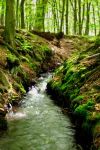
Ezekiel 47:12 reads, “On the banks on both sides of the river, there will grow all kinds of trees for food. Their leaves will not wither nor their fruit fail, but they will bear fresh fruit every month, because the water for them flows from the sanctuary. Their fruit will be for food and their leaves for healing.”
This passage speaks of abundant living. By ensuring that our sacred waters are not poisoned, we know we can maintain healthy ecosystems. We know too that water can continue to be a source of life to heal all of Creation. Genesis 2:7 states that we were made from the earth- the adamah. We are part of the interdependent web of Creation. When one part of the web suffers, all Creation suffers. By caring for our bodies and reducing toxics in our waterways, we can honor the rest of Creation.
Water contamination occurs in many ways. Here are some examples. A number of chemicals have ended up in our waterways threatening the health of our oceans, rivers, streams, and lakes. One case that comes to mind such as evidence surfacing last year of prescription drugs and estrogen containing chemicals in personal care products ending up in the nation’s rivers. The PBS Frontline report Poisoned Waters focused on this issue in the Potomac River last week. Government scientists have found links with these chemicals and the rise of intersexed fish. What this means for humans is unclear. Other chemicals are known to bioaccumulate up the food chain and can be quite toxic by the time they are in our bodies or women’s breast milk.
Some estrogenic chemicals are now leaching from plastics that contain beverages or food. BPA (bisphenol-a) is the probably the best known at the moment. It has been found in 93% of Americans. It is the building block of polycarbonate plastic but erodes over time into beverages and food it contains, especially when heated. It has been linked in animal studies to early puberty in girls, cardiovascular  disease, and type II diabetes. A new report card from investors released on April 21st gave companies below average or failing grades in terms of seeking out alternatives and developing plans to switch to safer materials. Federal legislation has been introduced to ban this chemical in food and beverage containers. You can send a letter to your representative or senator calling for a ban in place of safer alternatives here.
disease, and type II diabetes. A new report card from investors released on April 21st gave companies below average or failing grades in terms of seeking out alternatives and developing plans to switch to safer materials. Federal legislation has been introduced to ban this chemical in food and beverage containers. You can send a letter to your representative or senator calling for a ban in place of safer alternatives here.
 Another example of water contamination is of the Holt family highlighted in the United Church of Christ report Toxic Waste and Race at 20. The water in their community was contaminated with TCE but their predominantly African American community in Dickson, TN was not made aware of this for over twelve years when white communities nearby were told immediately after testing occurred in 1993 finding TCE in their water wells. Many members of the Holt family developed cancer and Harry Holt died from it in 2007. This is a classic example of environmental racism.
Another example of water contamination is of the Holt family highlighted in the United Church of Christ report Toxic Waste and Race at 20. The water in their community was contaminated with TCE but their predominantly African American community in Dickson, TN was not made aware of this for over twelve years when white communities nearby were told immediately after testing occurred in 1993 finding TCE in their water wells. Many members of the Holt family developed cancer and Harry Holt died from it in 2007. This is a classic example of environmental racism.
By keeping our sacred waters clean, they can be a healing source for us and all of Creation. By failing to do so, we put the health of our whole planet in peril.
Check out our resources on water: http://www.nccecojustice.org/resources.html#waterresources

It is interesting to see your topics of water and pollution covered from a Christian perspective. Very refreshing! I agree we have let things go too far!- Nate
By: berkey water filters on April 24, 2009
at 9:40 pm
Do you honestly think that it’s worth it to go into an area where you’re unsure about the safety of your drinking water? I have 2 children and I can assure you, I’d be damned if I don’t get water test kits from the local lab before moving into a residence. I can’t just rely on spending money on water filters for every use?
By: David Smokler on July 14, 2009
at 3:52 pm
While my post does not address your specific question one way or the other, it is a good idea to have your water tested when you move into a new place, especially if you have small children.
People don’t always have a choice though in where they live and the water quality they will have access to. Investigating an affordable filter is one solution and pressuring the local government to clean up the water source is another.
By: Chloe Schwabe on July 27, 2009
at 7:29 pm